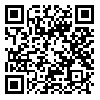Volume 13, Issue 5 (Dec & Jan 2020)
payavard 2020, 13(5): 401-410 |
Back to browse issues page
Download citation:
BibTeX | RIS | EndNote | Medlars | ProCite | Reference Manager | RefWorks
Send citation to:



BibTeX | RIS | EndNote | Medlars | ProCite | Reference Manager | RefWorks
Send citation to:
Changizi V, Zare M R, Kasiri S. Investigation of Absorption and Distribution of Natural Radionuclides in the Product Rice in Mahmoodabad City to Estimate Cancer Risk. payavard 2020; 13 (5) :401-410
URL: http://payavard.tums.ac.ir/article-1-6904-en.html
URL: http://payavard.tums.ac.ir/article-1-6904-en.html
1- Professor، Department of Radiation Sciences, School of Allied Medical Sciences, Tehran University of Medical Sciences, Tehran, Iran
2- Assistant Professor, Institute of Applied Physics, Tehran, Iran
3- Master of Science in Radiobiology and Radiation Protection, School of Allied Medical Sciences, Tehran University of Medical Sciences, Tehran, Iran ,M.Kasiri70@gmail.com
2- Assistant Professor, Institute of Applied Physics, Tehran, Iran
3- Master of Science in Radiobiology and Radiation Protection, School of Allied Medical Sciences, Tehran University of Medical Sciences, Tehran, Iran ,
Abstract: (2254 Views)
Background and Aim: Due to the presence of ionizing radiation sources in the environment and their potential to enter the food chain, the natural radiation in the rice product of Mahmoud Abadu residents of this area should be evaluated.
Materials and Methods: Using standard sampling methods, the number of sampling points and locations (about 10 points) was determined. After recording the geographical location of the sites, 2 kg of soil and 2 kg of rice were removed and 20 samples were coded. 950 g of soil and rice were milled and transferred to standard Marinelli dishes with 50 mesh. The samples were completely sealed and after about one month, they were visualized with ultra-pure germanium detectors (HPGe). Subsequently, specific radionuclide radiosensitivity in soil and rice soil samples, radionuclide transfer factors from soil to rice, annual effective dose and risk of cancer due to rice consumption were measured.
Results: Effective total dose of nuclei studied in #value, lifetime cancer risk of U238 from #value to 0.00019, Ra226 from #value to 0.00008, U235 # value, Th232 from #value to 0.00027, K40 From 0.00014 to 0.00082 and finally for zero cesium.
Conclusion: There is no harmful effect on the people of the region regarding the radionuclides of rice.
Materials and Methods: Using standard sampling methods, the number of sampling points and locations (about 10 points) was determined. After recording the geographical location of the sites, 2 kg of soil and 2 kg of rice were removed and 20 samples were coded. 950 g of soil and rice were milled and transferred to standard Marinelli dishes with 50 mesh. The samples were completely sealed and after about one month, they were visualized with ultra-pure germanium detectors (HPGe). Subsequently, specific radionuclide radiosensitivity in soil and rice soil samples, radionuclide transfer factors from soil to rice, annual effective dose and risk of cancer due to rice consumption were measured.
Results: Effective total dose of nuclei studied in #value, lifetime cancer risk of U238 from #value to 0.00019, Ra226 from #value to 0.00008, U235 # value, Th232 from #value to 0.00027, K40 From 0.00014 to 0.00082 and finally for zero cesium.
Conclusion: There is no harmful effect on the people of the region regarding the radionuclides of rice.
Send email to the article author
| Rights and permissions | |
 |
This work is licensed under a Creative Commons Attribution-NonCommercial 4.0 International License. |





